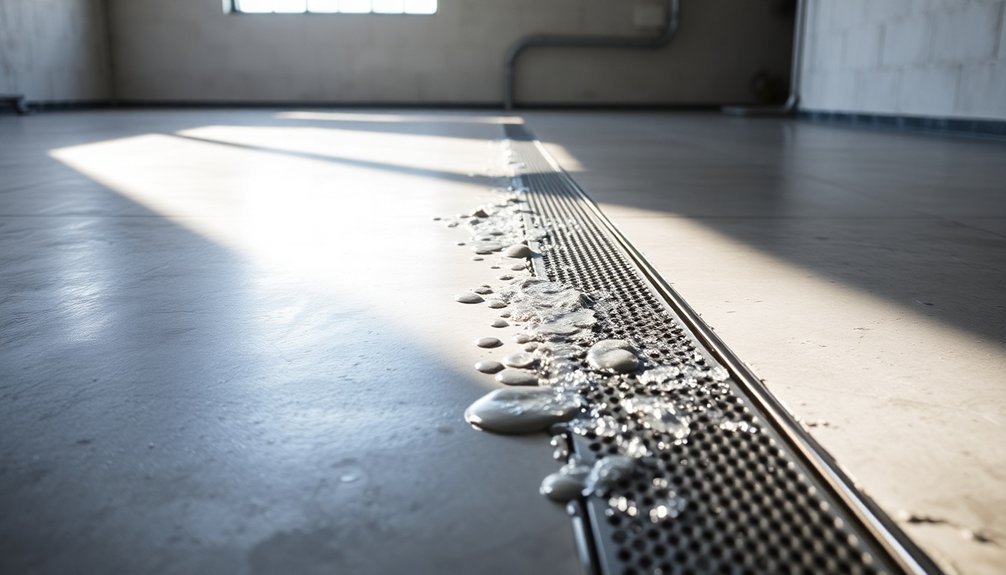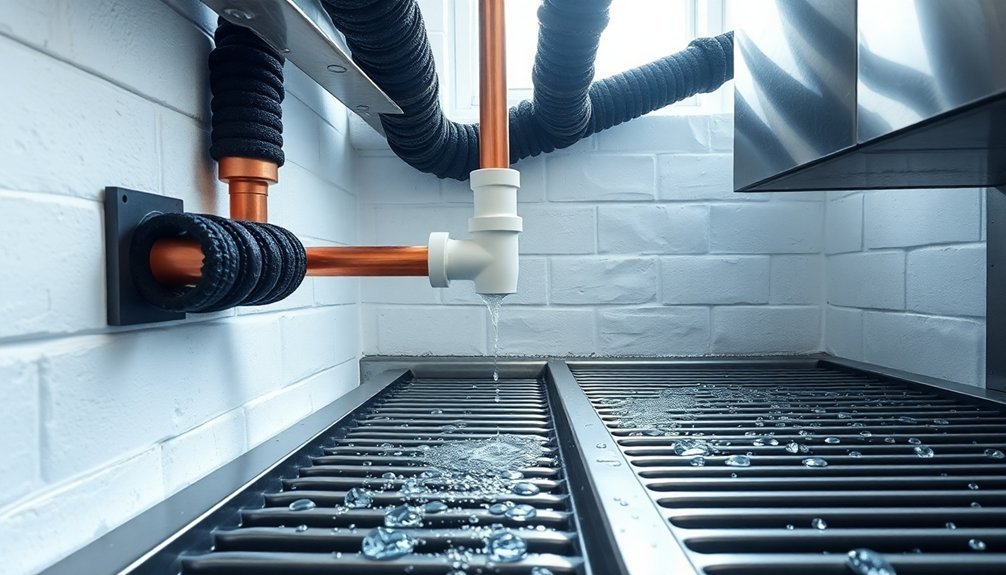Three proven drainage methods will keep your ice house running smoothly. First, install a floor drain system with a proper 2-inch air gap and 1/4" slope per foot to handle high volumes of melting ice. Second, utilize wall drainage solutions with P-traps if you're tight on space – they're perfect for countertop ice machines and save valuable floor area. Third, implement transfer and extended piping systems when your ice machine sits far from main drainage points, ensuring proper slope and freeze protection. These smart drainage solutions just scratch the surface of keeping your ice house operating at peak efficiency.
Floor Drain Systems

Throughout an ice house, floor drain systems serve as the primary method for managing water from melting ice and equipment maintenance.
You'll find several types of floor drains available, including round drains for simple, high-volume applications and square drains that offer larger surface areas for increased water handling capacity. Floor sinks and mop sinks provide additional options depending on your specific needs and structural constraints.
When you're installing a floor drain system, you'll need to maintain a proper air gap, typically 2 inches, to prevent sewage backflow into your ice maker. It's essential to position the drain access point directly under your ice maker and guarantee a 1/4" drop per foot of drain line for effective gravity drainage. Using clean drainage stone around the drain helps prevent clogging and ensures optimal performance.
You'll also need to comply with local health codes throughout the installation process.
While floor drains offer efficient water flow and easy maintenance, you'll want to watch for potential challenges. Keep an eye out for clogging issues and verify your installation meets all requirements, including proper slope and air gap specifications.
If you're dealing with structural limitations or space constraints, you might need to explore alternative solutions or custom drain designs.
Wall Drainage Solutions
A well-designed wall drainage system provides a space-saving solution for commercial ice machines, particularly countertop models.
You'll need to verify your wall drain can handle your ice maker's water volume and connects properly to either an outdoor drainage point or existing plumbing system. When you're connecting to a sewage line, don't forget to install a P-trap to prevent backflow. Regular preventive drain cleaning helps avoid costly maintenance issues down the line.
You must maintain a proper air gap between your ice maker's drain line and the wall drain access point. While 2 inches is typical, you'll want to check your local health codes, as requirements can vary by location. This gap is essential for preventing contamination and guaranteeing your system meets safety standards.
When installing your wall drainage system, you'll need to use durable materials like PVC or ABS pipes that can withstand consistent water flow.
Make sure you're creating a proper slope for gravity-fed drainage and sealing all connections thoroughly. If your ice machine isn't elevated enough, you'll need to install a drain pump.
Remember to perform regular maintenance checks for clogs and monitor the system for any signs of backup or leakage.
Transfer and Extended Piping

While wall drains work well for nearby connections, transfer drains and extended piping become necessary when your ice machine sits far from drainage access points. You'll need to maintain a 1/4" drop for every foot of drain line length to guarantee proper gravity-assisted flow. When installing a transfer drain, make certain your bin drain sits above the commercial-grade pump, which should be positioned 10-14 inches off the ground.
| Component | Requirement | Solution |
|---|---|---|
| Transfer Drain | 1/4" drop per foot | Guarantee proper slope alignment |
| Extended Piping | Freeze protection | Install pipe heater tape |
| Clean Outs | Regular access | Include maintenance points |
For extended piping installations, you'll need to take into account freeze protection in areas with significant frost depth. It's smart to incorporate clean outs into your system, allowing you to address ice blockages with deicing salts or hot water when needed. Consulting with local geologists can provide valuable insights about water table dynamics and drainage effectiveness. Consider using SMART DRAIN™ systems to separate water from soil particles, reducing clog risks. In extreme climates, you might need to winterize your piping or implement heated solutions to prevent ice formation. Remember to account for the six inches of clearance that ice machine drain pumps typically require.
Frequently Asked Questions
How Often Should Commercial Ice Machine Drain Lines Be Cleaned?
You'll need to clean your commercial ice machine drain lines daily for debris removal, weekly for blockage checks, and monthly for mineral buildup inspection. Don't skip these intervals to prevent drainage issues.
Can Drain Water From Ice Machines Be Recycled for Other Purposes?
You can recycle ice machine drain water for non-potable uses like plant watering or cleaning, but you'll need to guarantee it's properly filtered and sanitized first. It's not safe for drinking purposes.
What Temperature Changes Can Affect Ice Machine Drainage Performance?
You'll notice decreased drainage performance when temperatures drop below freezing, causing pipe blockages, and when high temperatures create excess condensation. Both extremes can disrupt your ice machine's normal drainage flow.
Are There Specific Regulations for Ice Machine Drainage in Food Establishments?
You'll need to follow FDA Food Code regulations requiring air gaps between drains and sewer lines, P-traps to prevent gas backflow, and proper drain slopes of ¼ inch per foot for your ice machine installation.
Which Drain Sanitizing Products Are Safe for Ice Machine Drainage Systems?
You'll want to use nickel-safe cleaners like QuikSan or IMS-III sanitizer at proper dilutions (200-250 ppm quat). Mix with warm water and guarantee surfaces stay wet for 60 seconds for effective sanitization.
In Summary
You'll find these three ice house drainage methods can transform how you manage water flow and prevent damage. Whether you choose floor drains, wall solutions, or extended piping systems, proper installation is essential for success. Don't forget to maintain your chosen drainage system regularly and keep it clear of debris. When implemented correctly, these methods will protect your ice house investment for years to come.





Leave a Reply